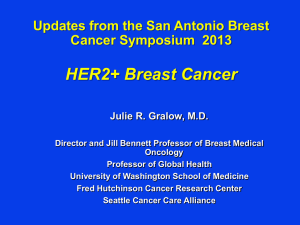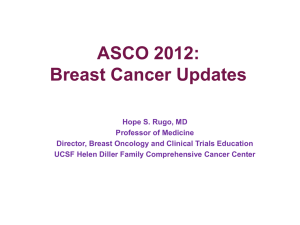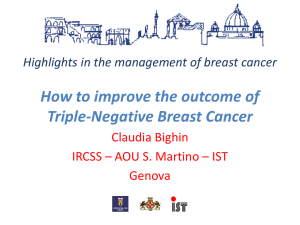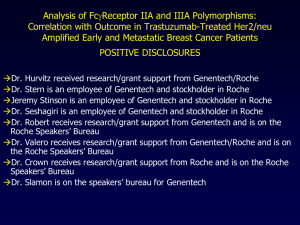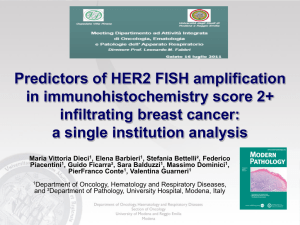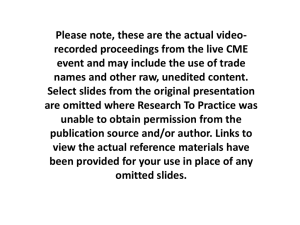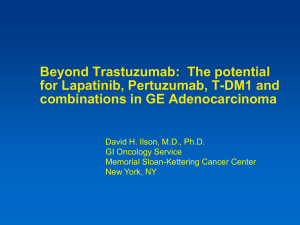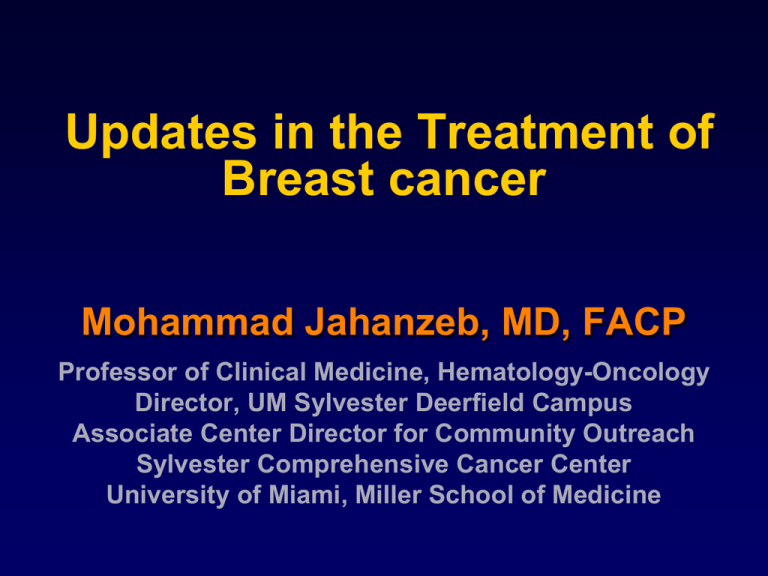
Updates in the Treatment of
Breast cancer
Mohammad Jahanzeb, MD, FACP
Professor of Clinical Medicine, Hematology-Oncology
Director, UM Sylvester Deerfield Campus
Associate Center Director for Community Outreach
Sylvester Comprehensive Cancer Center
University of Miami, Miller School of Medicine
Clinical Breast Cancer Subsets
defined by IHC
ER+
65-75%
All Breast Cancers
HER2+
15-20%
Triple
negative
15%
H Burstein and A Goldhirsch St Gallen 2007
HER2 Positive Disease
Milestones of HER2/anti-HER2 therapies in BC
1978
1982
1983
1984
1985
1987
1998
2006
2010
2007
2013
2012
EGFR discovery
Cohen
FDA approves
trastuzumab
alone for 2nd
line and in with
paclitaxel for 1st
line MBC
neu oncogene
discovery
Weinberg
Her2 cloned
Ullrich and
Coussens
EGFR MoAb
inhibited
growth
Mendelsohn
Her2/neu
amplification
correlates with
shorter survival
Slamon
Her2
amplification in
breast cancer
Aaronson
MBC : metastatic breast cancer; MoAb : monoclonal antibody
FDA approves
lapatinib +
letrozole for
MBC
FDA approves
trastuzumab
emtansine for
MBC
FDA approves
lapatinib +
capecitabine
for MBC
FDA approves
trastuzumab in
adjuvant
setting
FDA approves
pertuzumab +
trastuzumab +
docetaxel for
MBC
Accelerated
approval of
pertuuzmab/
trastzumab as
neoadjuvant
therapy
Expanding Options in HER2 Targeting
Block heterodimerization
– Add pertuzumab
Antibody-toxin conjugate
– TDM1
Downstream pathway inhibition
– Block MTOR/PI3K?
Oral panHER TKI
– Lapatinib, neratinib
Alternate antibody-drug conjugate
– MM302
Optimal HER-2 Directed Therapy Sequencing for
HER-2+ Advanced Breast Cancer
Verma S et al. The Oncologist 2013;18:1153-1166
©2013 by AlphaMed Press
First results from the phase III ALTTO trial (BIG 02-06; NCCTG 063D) comparing one year of anti-HER2 therapy with lapatinib alone (L), trastuzumab alone (T), their sequence (T L)
or their combination (L + T) in the adjuvant treatment of HER2-positive <br />early breast cancer (EBC)
Presented By Martine Piccart-Gebhart at 2014 ASCO Annual Meeting
Adjuvant Lapatinib (ALTTO) Schema
n=8381 total/6281 analyzed
Chemotherapy
+ Trastuzumab X 1 year
+ Lapatinib X 1 year
HER2+
ESBC
+ Trastuzumab+ Lapatinib X 1 year
+ Trastuzumab X 3 months →
Lapatinib X 9 months
Different treatment approaches
• Sequential anti-HER2 therapy after all chemo (N= 4,613)
• Concurrent anti-HER2 therapy after anthracycline-based chemo (N=3,337)
• Concurrent anti-HER2 therapy with non-anthracycline chemo (N=431)
Piccart et al, ASCO 2014
DISEASE-FREE SURVIVAL (DFS) ANALYSIS
Presented By Martine Piccart-Gebhart at 2014 ASCO Annual Meeting
OVERALL SURVIVAL (OS) ANALYSIS
Presented By Martine Piccart-Gebhart at 2014 ASCO Annual Meeting
Take Home Message from
ALTTO
While there was doubling of pCR in the
NEOALTTO study, it did not translate into
improved survival outcomes in ALTTO at 4.5
years follow up
There was increased toxicity noted with lapatinib:
diarrhea, rash or erythema
APHINITY ADJUVANT TRIAL
N=4805
TCa x 6
Completed recruitment
on 31-Aug-2013
TCa x 6
TCa = 6 cycles of docetaxel and carboplatin
11
I-SPY 2 Trial Neratinib Arm
HER2(+) Subset
(n = 66 v 22 control)
Signature
Estimated pCR rate
Neratinib Concurrent
Controls
Probability
Neratinib is
Superior to
Control
Predicted
Probability of
Success in
Phase 3
HER2+/HR-
56%
33%
95%
79%
HER2+/HR+
30%
17%
91%
65%
Neratinib is an oral dual HER2 and EGFR tyrosine kinase inhibitor
Park et al AACR 2014
Neratinib
Phase III Trials
– Extending adjuvant therapy
– Nala trial
Neratinib/capecitabine vs
lapatinib/capecitabine
> 2 lines of HER2 targeted regimens for MBC
– ISPY3
Neoadjuvant trial to follow ISPY2
Afatinib
– Lux trial
Vinorelbine/afatinib vs vinorelbine/trastuzumab
Can HER2 PET Predict Response to Anti-HER2 therapy?
THE ZEPHIR TRIAL
Presented By Geraldine Gebhart at 2014 ASCO Annual Meeting
Slide 9
Presented By Geraldine Gebhart at 2014 ASCO Annual Meeting
Conclusions
Absence of HER2 target per HER2 PET predicts
treatment failure
Imaging early treatment response with FDG PET
predicts treatment success
Combining both imaging modalities improves
predictive accuracy
– HER PET+/FDG decline – 100% PPV
– HER2 PET-/No FDG decline- 100% NPV
Hormone Receptor
Positive Disease
Current Standard Options for Adjuvant
Endocrine Therapy
Menopausal Status
at Diagnosis
Pre / perimenopausal
Postmenopausal
Initial Therapy
Extended Therapy
Tamoxifen5
Tamoxifen5
Tamoxifen5
AI5 (*if post-menopausal)
AI5
Tamoxifen2-3
AI2-3
Tamoxifen5
AI5
Tamoxifen5
Tamoxifen5
There are insufficient data currently to recommend AI for > 5
years
What about ovarian suppression?
What about AI + OFS in premenopausal women?
Adapted from ASCO Guidelines 2014. Available at: www.asco.org
SOFT/TEXT
SOFT: SUPPRESSION OF OVARIAN FUNCTION TRIAL
TEXT: TAMOXIFEN AND EXEMESTANE TRIAL (at NYU)
Both Phase III Trials; Exemestane Plus gonadotrophin-releasing hormone
(GnRH) Analogue as adjuvant therapy for premenopausal women with
hormone receptor positive breast cancer
Question: is temporary ovarian function suppression with GnRH
analogues (ovarian ablation permanent with surgery or radiation) useful
when combined with AI or TAM.
Goserelin (zoladex 3.6 sc monthly), leuprorelin (lupron 3.75 im monthly),
buserelin, triptorelin (3.75 im monthly)
DFS event rate much lower than anticipated combined analysis (4690
patients)
TEXT & SOFT
Tamoxifen + OFS vs. Exemestane + OFS
Stratified by trial, use of chemotherapy, nodal status
TEXT
Premenopausal, HR+ BC
Tamoxifen 20 mg/day
+ OFS* (n = 1338)
Joint Analysis
Tamoxifen + OFS*
≤ 12 wks after surgery
N = 2672
•
SOFT
Premenopausal HR+ BC
≤ 12 wks after surgery
(if no chemo) or
•
≤ 8 mos after chemo if
Exemestane 25 mg/day
+ OFS* (n = 1334)
Tamoxifen 20 mg/day
+ OFS* (n = 1024)
Exemestane 25 mg/day
+ OFS* (n = 1021)
N = 2344
Median follow up: 68 months
42% N+
Neo/Adjuvant chemotherapy:
58%
Exemestane+ OFS*
premen status confirmed
•
N = 3066
Tamoxifen 20 mg/day
*OFS
TEXT: triptorelin 3.75 mg IM every 28 days for 6-8 weeks prior to initiation of
HT or concurrently with chemotherapy.
SOFT: triptorelin, bilateral oophorectomy or Ovarian irradiation
N = 2346
Pagani O, et al. NEJM July 2014.
SOFT/TEXT: Exemestane + OFS
better DFS
Median f/u 5.7 years
SOFT/TEXT: selected AEs
QOL not different
Early cessation of treatment 16 vs 11%
SOFT/TEXT: take home message
Low event rates
Exemestane with ovarian function suppression is a new
evidence based treatment option for premenopausal
women with HR+ early breast cancer
Important question from SOFT (tamoxifen+OFS vs
tamoxifen) will be answered end of 2014
Some premenopausal women diagnosed with HR+
breast cancer have an excellent prognosis with highlyeffective endocrine therapy alone (>97% BC free at 5
yrs)
Need longer f/u, esp OS
ABCSG-12: Study Design
Key endpoints
– Primary: DFS at 5 yrs
– Secondary: relapse-free survival, OS, BMD, safety
Treatment 3 yrs
(median follow-up: 62 mos)
1803 premenopausal pts with
stage I/II BC
• 80% > 40 yrs
• N+ 30%
• OFS: Goserelin Q 28 days
• OFS started concurrently
with endocrine therapy
• Only 5% received
Chemotherapy
TAM 20 mg/day
ANA 1 mg/day
R
TAM + ZA 4 mg q6m
ANA + ZA 4 mg q6m
Long-term
monitoring
for 5 yrs
for
recurrence
and
survival
(DFS, OS)
3-yr
BMD
Gnant M, et al. N Engl J Med. 2009, Lancet 2011
5-yr
BMD
ABCSG-12 (84 Months)
ET + Zometa Vs ET
DFS
80
80
60
60
88% vs 92 % p=0.009
40
40
20
20
0
0
0
12
24
36
48
60
72
84
96 108
Mos Since Randomization
Patients at Risk, n
No ZA 903 858 833 807
ZA
900 862 841 822
758 653
788 674
Gnant M, et al. Lancet 2011.
OS
100
OS (%)
DFS (%)
100
521 405
544 419
95% vs 97% p=0.09
0
12
24
36
48
60
72
84
96 108
Mos Since Randomization
191
208
Patients at Risk, n
No ZA 903 864 856 839
ZA
900 868 858 849
811 706
818 708
576 456
587 454
215
232
ABCSG-12 (84 Months): DFS
Tamoxifen vs AI
Conclusions
Highly effective endocrine therapy alone offers
excellent prognosis for some premenopausal
women with HR+ BC
– 95% 5 year OS in all three studies.
Role of OFS: Await data on Tam vs Tam +
OFS
Side effects of OFS should not be
underestimated.
I am not ready to use AI + OFS in
premenopausal women yet.
Targeted Therapies for ER+ MBC
CDK 4/6 regulates
cell cycle progression
•
Palbociclib is an oral,
potent inhibitor of CDK4/6
•
PALOMA-1:
–
Palbo + Letrozole is superior
to Letrozole in 1st line ER+
MBC (median PFS 20.2 vs.
10.2 mo, HR 0.49, p=0.0004)
CDK4/6 inhibitor summary
Palbociclib improves PFS with letrozole
– Confirmatory phase III trials ongoing
– Watch for maturing data in combination with fulvestrant or paclitaxel
Several other CDK4/6 inhibitors in development, such as
abemaciclib and LEE011
Many remaining questions:
– Is there an optimal endocrine, chemotherapy or targeted therapy
partner?
– How do we sequence these relative to everolimus?
– What are mechanisms of resistance?
Presented by: Tiffany A. Traina, MD
Next?
Palbociclib: accelerated FDA submission
expected
PALOMA 2 (Letrozole +/-)
PALOMA 3 (Faslodex +/-)
Novartis: Monaleesa (Let +/-)
Lilly: RTC
Others?
Triple Negative Disease
TNBC patients have a worse
prognosis NTN stage I
TN stage I
Non TN stage II
TN stage II
Non TN stage III
TN stage III
Bauer et al Cancer May 2007
Triple-negative phenotype and
molecular sybtypes.
Carey L A The Oncologist 2010;15:49-56
TNBC Shares Clinical and Pathologic
Features With BRCA1-Related Breast
Cancers
Characteristics
ER/PR/HER2 status
TP53 status
BRCA1 status
Gene-expression pattern
Tumor histology
Chemosensitivity to DNAdamaging agents
Hereditary BRCA1
Triple Negative/Basal-like[1-3]
Negative
Negative
Mutant
Mutant
Mutational inactivation*
Diminished expression*
Basal-like
Basal-like
Poorly differentiated
(high grade)
Poorly differentiated
(high grade)
Highly sensitive
Highly sensitive
*BRCA1 dysfunction due to germline mutations, promoter methylation, or overexpression of HMG or ID4[4]
1. Perou CM, et al. Nature. 2000; 406:747-752.
2. Cleator S, et al. Lancet Oncol. 2007;8:235-44.
3. Sorlie T, et al. Proc Natl Acad Sci U S A. 2001;98:10869-10874.
4. Miyoshi Y, et al. Int J Clin Oncol. 2008;13:395-400.
Platinum Agents in TNBC
Good preclinical rationale, particularly in BRCA-associated
Clinical data:
Trial
Population
Results
Control arm BALI-1 (CDDP)
Sporadic TNBC
10% RR
Control arm phase III iniparib (gem/carbo)
Sporadic TNBC
30% RR
TBCRC 001 (cetuximab/carbo)
Sporadic TNBC
17% RR
BRCA1+
86% pCR
Sporadic TNBC
15% pCR
14-pt trials neoadj CDDP (Byrski + Silver)
24-pt trial neoadjuvant CDDP (Silver)
Clinical role of platinums less clear: promising in BRCA+
CALGB 40603 and other trials designed to clarify
Baselga J, et al. Ann Oncol. 2010;21(Suppl 8). Abstract 274O. O’Shaughnessy J, et al. J Clin Oncol.
2011;29(Suppl). Abstract 1007. Carey L, et al. 2008;26(Suppl). Abstract 1009. Byrski T, et al. J Clin Oncol.
2010;28:375-379. Silver DP, et al. J Clin Oncol. 2010;28:1145-1153.
Neoadjuvant Carboplatin for TNBC
Summary of recent randomized trials
Study
Design
N
pCR
Control Platinum
GeparSixto
nplDox/Pac/Bev
+/- wCb (AUC1.5) X 18 wks
315
42.7%
53.2%
ALLIANCE 40603
2x2 design
wPac +/- Cb (AUC 6) +/- bev
AC X 4
433
41%
54%
GEICAM/2006-03
ECX4D +/-Cb AUC6 X 4
94
30%
30%
ISPY2
wPac+/-Cb/veliparib ACx4
71
26%(est)
52%(est)
Both GeparSixto and CALGB 40603 included Bev along
with Cb and I spy included PARPi
von Minckwitz, Lancet Oncol 2014; 15: 747–56; Sikov, SABCS 2013; Rugo SABCS 2013; Alba, BCRT, 2012 (136)
Randomized phase II study of weekly paclitaxel with and
without carboplatin followed by cyclophosphamide /
epirubicin / 5-fluorouracil as neoadjuvant chemotherapy
for stage II/IIIA breast cancer.
Kenji Tamura, Jun Hashimoto, Hitoshi Tsuda, Masayuki Yoshida, Hideko
Yamauchi, Kenjiro Aogi, Satoru Shimizu, Hiroji Iwata, Norikazu Masuda, Naohito
Yamamoto, Kenichi Inoue, Shinji Ohno, Katsumasa Kuroi, Tamie Sukigara,
Yasuhiro Fujiwara, Masashi Andoh
Abstract 1017
Aims
• Compare pCR in HER2 Negative tumors with
paclitaxel +/- carbo followed by CEF (note: ER+ and
TNBC combined)
• Evaluate pretreatment biomarkers Ki-67, EGFR,
Cytokeratin (CK) 5/6, BRCA1, vimentin, ERCC1 and
ZEB1 by IHC
Study Schema
Paclitaxel
80 mg/m2 qwk x 12
CP-CEF
Carboplatin
AUC5
q3wks x 4
R
Enrolled 181 pts
N= 75 for TNBC
56% Node positive
P-CEF
Paclitaxel
80 mg/m2 qwk x 12
CEF
500/100/500 mg/m2
q3wks x 4
S U R G E R Y
HER2 (-) BC
Stage II/IIIA
18-70 years
PS 0/1
Good Organ
function
Written IC
CEF
500/100/500 mg/m2
q3wks x 4
Results
100
80
pCR rate (%)
pCR rate (%)
80
pCR rates
100
Primary
Endpoint
P =0.04
60
32%
40
17%
20
0
CP-CEF P-CEF
All patients
62%
60
40
26%
20
0
CP-CEF P-CEF
TNBC patients
p= N.S.
p=0.040
pCR rates by
EGFR
expression
pCR rate
(%)
80
p=0.010
63.6
60
45.0
40
20
11.5
22.2
18.2
6.7
0
All
CP
EGFR-
P
All
CP
EGFR+
P
Mechanisms of Synthetic
Lethality-PARP-1
41
Image from: Iglehart JD, Silver DP. Synthetic Lethality-A new direction in cancer-drug
development. NEJM 2009; 361 (2) ; 189-191. 2009 Massachusetts Medical Society.
All rights reserved. Permission requested.
I-SPY 2 TRIAL:
Learn, Drop, Graduate, and Replace Agents Over Time
Paclitaxel+
Trastuzumab
Randomize
HER 2
(+)
Paclitaxel +
Trastuzumab* +
New Agent A
Paclitaxel +
Trastuzumab* +
New Agent B
AC
Learn and adapt
from each patient as
we go along
Paclitaxel
Paclitaxel ++
Trastuzumab*
Trastuzumab* ++
New
New Agent
Agent F
C
Patient
is on
Study
Key
Paclitaxel
Randomize
MRI
Residual
Disease
Surgery
HER 2
(–)
Paclitaxel +
F
New Agent C
Paclitaxel +
New
NewAgent
AgentGH
D
AC
Surgery
(Pathology)
Paclitaxel +
New Agent E
42
The I-SPY 2 Bayesian model
estimates the probability distribution
of pCR rates in each signature
Actual pCR rates are biased by the
adaptive randomization and are
not calculated
Rugo et. al. SABCS 2013
Veliparib/Carboplatin GRADUATES
in the Triple Negative Signature
Estimated pCR Rate
(95% probability interval)
SIGNATURE
All HER2HR+/HER2-
HR-/HER2-
Veliparib/ Concurrent
Carbo
Control
33%
22%
(22-43%)
(10-35%)
14%
19%
(4-27%)
(6-35%)
52%
26%
(35-69%)
(11-40%)
Probability
Veliparib +
Carbo is
Superior to
Control
Predictive
Probability of
Success in
Phase 3
92%
55%
28%
9%
99%
90%
Rugo et. al. SABCS 2013
PARP Inhibitors in Development
•
•
•
•
•
•
•
•
•
Olaparib (Astra Zeneca) PO
Veliparib (ABT888 - Abbvie) PO
BMN-673 (Biomarin) PO
Niraparib (MK-4827) PO
CEP 9722 (Cephalon) PO
GPI 21016 (MGI Pharma) PO
Iniparib (BSI 201 – Sanofi-Aventis) IV
Rucaparib aka AGO 14699 (Pfizer) IV
INO 1001 (Inotek – Genentech/Roche) IV
• Others?
TNBC: potential therapeutic targets
Mayer I A et al. Clin Cancer Res 2014;20:782-790
©2014 by American Association for Cancer Research
Novel Agents in Development for TNBC
Met inhibitor: ARQ197, onartuzumab
(Metmab), foretinib
PI3K and/or inhibitor: BKM 120,
temsirolimus (+ neratinib)
HDAC inhibitors: entinostat, vorinosat
Demethylating agents: azacitidine
(+ entinostat)
PARP inhibitors: ABT-888, E7449,
Biomarin-BMN673, AZD2281,
rucaparib
Olaparib+ BKM120;
Angiogenesis inhibitor: cediranib
(+ olaparib), ramicurumab, IMC18F1,
foretenib, sorafenib
Hsp90 inhibitors: ganetespib
Aurora kinase inhibitors: ENMD 2076
Androgen Receptor Blockers:
EGF inhibitors: erlotinib (+
metformin), apatanib
Lucitanib (FGFR+VEGF inhibitor)
Masitinib (C-Kit inhibitor)
MEK inhibitors: GSK1120212
Wnt inhibitor: LGK974
CDK inhibitor: dinaciclib, P276-00
FMS-Kit inhibitor: PLX3397
Apoptosis inducer: LCL161
(deactivating inhibitor of apoptosis
proteins)
Immunotherapy: MUC1 vaccine,
adoptive cellular therapy (DC-CIK)
Cytotoxics: SN38 -NK012, AEZS108 (LHRH-dox);
Checkpoint inhibitors (anti PD-1, anti
PDL-1)
Biologics in Breast Cancer:
Bevacizumab
Antibody designed to normalizing the tumor blood vessels
(antiangiogenic) and aid delivery of chemotherapy: Avastin
(Bevacizumab)
E5103: addition of Bev to standard AC-T in women with
high risk breast cancer
LN+
LN – (TN>1cm, HR+ >5 cm or <5 cm with oncotype >11)
Bev at 15mg/kg given concurrently with chemo and +/maintenance
In 2010 FDA rescinded Bev approval for metast BC
E5103: Bevacizumab
2986 patients
No benefit from
addition of Bev
Bevacizumab: take home message
No role for bevacizumab in breast cancer
(FDA approval rescinded for metastatic
disease and no benefit shown in earlier
stages, including E5103)
Biospecimen bank with be utilized for
predictors of toxicity and late relapse
SWOG Proposed Study
TNBC
Post NAC
PT1C or N+
N=400
Placebo x 1 year
Primary
endpoint:
DFS
R
MK3475 x 1 year
Anti-PD1 antibody
A randomized, phase III trial to evaluate the efficacy and safety of MK3475 as adjuvant therapy for triple receptor-negative breast cancer
with >1 cm residual invasive cancer or any positive lymph nodes
(>pN1mic) after neoadjuvant chemotherapy
Slide 28
Presented By Melinda Telli at 2014 ASCO Annual Meeting
EA 1131A
Placebo
TNBC
Post NAC
PT1C or N+
Primary
endpoint:
DFS
R
Carboplatin X 4
cycles
EA 1131A : A randomized, phase III trial to evaluate the efficacy of
adjuvant carboplatin for triple receptor-negative breast cancer with
residual invasive cancer
SAFIR 01 Molecular-Driven Study Flow
427 Enrolled
407 MBC Bx
(13%) 55 Genomic-driven Rx
299 Genomics
195 Druggable Lesions
Most Activating Mutations are Rare
Andre F, et al. Lancet Oncol 2014
17 Targeted Regimens
SAFIR 01
Study
Outcomes
Targets addressed:
•
PI3KCA mutation
•
EGFR amplification
•
AKT mutation
•
FGFR amplification
•
IGF-1R amplification
Overall Benefit Rate:12/407
(3%)Response Rate: 4/407 (1%)
Andre F, et al. Lancet Oncol 2014
PREVENTION, SUPPORTIVE CARE &
SURVIVORSHIP
Prevention of Early Menopause Study<br />(POEMS)-S0230<br /> Phase III trial of LHRH analog during chemotherapy to reduce ovarian failure in early stage, hormone receptornegative breast cancer: an international Intergroup trial of SWOG, IBCSG, ECOG, and CALGB (Alliance)
Presented By Halle Moore at 2014 ASCO Annual Meeting
Background
Presented By Halle Moore at 2014 ASCO Annual Meeting
POEMS/S0230 Schema
Presented By Halle Moore at 2014 ASCO Annual Meeting
Results
Ovarian failure at 2 years
– Standard chemotherapy: 15/69- 22%
– Standard chemotherapy + Goserelin: 5/66- 8%
More women attempted and achieved successful pregnancies
in the goserelin arm compared to the chemotherapy alone arm
– 12/113 (12%) vs 22/105: (21%)
Total number of babies: 12 vs 18
Increased menopausal symptoms during treatment
No negative impact on cancer outcomes
Take Home Message
Fertility preservation is an important issue
for young patients
Current Options:
- Ovarian Stimulation and embryo cryopreservation
- Oocyte cryopreservation
- Ovarian tissue cryopreservation (Experimental)
- GnRH agonist during chemotherapy?
Vitamin d and breast cancer<br />Background
Presented By Ana Elisa Lohmann at 2014 ASCO Annual Meeting
PROGNOSTIC ASSOCIATIONS OF 25OH VITAMIN D <br /> IN NCIC CTG MA.21 <br />A PHASE III ADJUVANT RANDOMIZED CLINICAL TRIAL <br />OF THREE CHEMOTHERAPY
REGIMENS<br /> (CEF, EC/T, AC/T) IN HIGH RISK BREAST CANCER <br /> <br /><br />
Presented By Ana Elisa Lohmann at 2014 ASCO Annual Meeting
Results
Sample size
– MA.21: N = 2104 patients
– Vit D sub-study: N = 934 patients
Low VIT D level was not associated with recurrence free
survival, breast cancer free survival or overall survival
However,
– Most patients had adequate VIT D levels at study entry (mean VIT D
level 27.9ng/ml), only 20% were deficient
– One time point
– Lack of data on VIT D supplementation
– Analysis of a subset of patients not fully representative of the entire
population
– Restrictive study population (white, young and with high risk BC)
Take Home Message
Link between VIT D and breast cancer
outcomes remains inconclusive
Randomized trial desirable but not feasible
– Common use of VIT D and better VIT D levels
– Patients with low level might not want to get
randomized to placebo
Effect of obesity in premenopausal
ER+ early breast cancer:
EΒCΤCG data on 80,000 patients in 70 trials
Independent prognostic factor (regardless of surgery type, tumor size,
grade, LN status, chemo, hormonal therapy)
Dose response: increasing BMI increasing BC mortality
Pan et.
al.PASCO201
4 abst # 503
Obesity confers worse outcomes
in premenopausal ER+ BC
Pan et. al. PASCO2014 abst # 503
THANK YOU!

